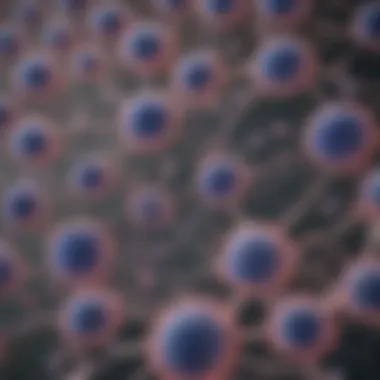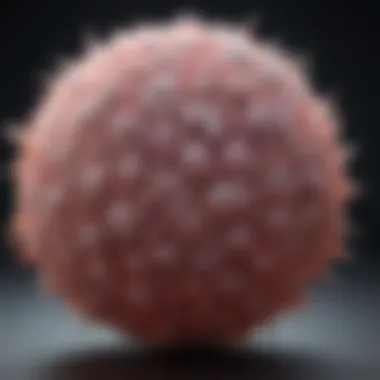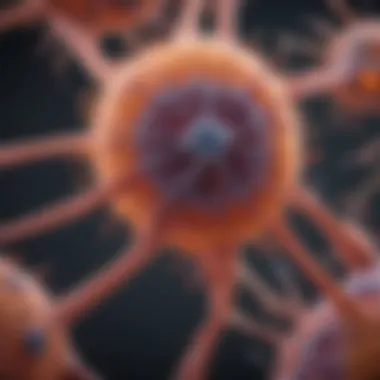Chondrocyte Cell Lines in Cartilage Research


Intro
Chondrocytes are specialized cells located in cartilage, crucial for maintaining its structure and function. Understanding chondrocyte biology is increasingly important in fields like regenerative medicine and disease research. The rise of chondrocyte cell lines has enabled scientists to study these cells in detail, examining their role in various conditions, especially cartilage degeneration and repair.
The significance of these cell lines cannot be overstated. They provide invaluable tools for exploring the mechanisms of cartilage-related diseases, such as osteoarthritis. Through in vitro experiments, researchers can investigate cellular behavior, responses to treatments, and the underlying molecular pathways that contribute to cartilage health and pathology.
In this article, we delve into the characteristics, functionality, and limitations of chondrocyte cell lines. We will evaluate their applications in scientific research, outlining both current methodologies and emerging trends that are shaping our understanding of cartilage biology.
Preamble to Chondrocytes
Chondrocytes are specialized cells primarily responsible for maintaining the structure and function of cartilage. They are vital in the study of cartilage biology, especially in the context of various diseases and conditions that affect joint health. Understanding these cells is essential not just for basic research but also for potential therapeutic applications.
In this section, we will define chondrocytes and discuss their functions. Additionally, we will explore their importance in maintaining cartilage health.
Definition and Function
Chondrocytes are unique in that they are the only cell type found within cartilage. They develop from mesenchymal stem cells during embryonic development and are responsible for producing and maintaining the extracellular matrix (ECM) of cartilage. This ECM is composed of collagen, proteoglycans, and water, providing cartilage with its rigidity and resilience.
One key function of chondrocytes is synthesizing collagen types II and IX, which are critical for cartilage structure. They also play a crucial role in maintaining the balance of anabolic and catabolic processes within the cartilage. By doing so, they regulate the synthesis of matricellular components and the amount of degradation enzymes, which is critical for cartilage homeostasis. When chondrocytes become dysfunctional, it can lead to degenerative joint diseases such as osteoarthritis.
Importance in Cartilage Health
The health of cartilage directly relates to the functionality of chondrocytes. Cartilage is avascular and lacks nerve supply, meaning it relies heavily on these cells for its maintenance and repair. As such, the well-being of chondrocytes is critical in preventing cartilage degeneration.
Here are several key points regarding the importance of chondrocytes:
- Cartilage Integrity: Chondrocytes maintain the structural integrity of the cartilage, ensuring that it can withstand mechanical stress during movement.
- Response to Injury: In cases of trauma or injury, chondrocytes are the first responders. They become activated to facilitate repair processes, although this repair is limited due to the avascular nature of cartilage.
- Disease Mechanism: Chondrocyte dysfunction is implicated in various arthritic disorders. Researching these cells can provide insights into the mechanisms underlying diseases like osteoarthritis.
"Chondrocytes play a pivotal role in the maintenance and repair of cartilage, making them crucial for joint health."
The above aspects highlight the necessity of studying chondrocytes in detail. Their understanding sets the groundwork for advancements in tackling cartilage-related diseases and developing new therapeutic strategies.
Chondrocyte Cell Lines Overview
Chondrocyte cell lines are essential in the study of cartilage biology. These cell lines enable researchers to investigate various aspects of cartilage health and disease. They serve as valuable tools for understanding the cellular mechanisms affecting cartilage homeostasis. Given the rising prevalence of cartilage-related issues, particularly osteoarthritis, the significance of these cell lines cannot be overstated.
The primary benefit of using chondrocyte cell lines is their ability to provide consistent and reproducible results in experiments. Unlike primary chondrocytes, which can exhibit variability due to their biological age and source, cell lines allow for standardized conditions. This consistency aids in the evaluation of drug responses and the underlying cellular actions.
Types of Chondrocyte Cell Lines
Chondrocyte cell lines can be classified into two main categories: immortalized and primary lines. Immortalized chondrocyte lines, such as ATDC5 and C-20/A4, possess enhanced growth capabilities and can be maintained for extended periods. They are derived from transformed cells and can adapt to various laboratory conditions. For instance, the ATDC5 cell line is often used in differentiation studies due to its ability to undergo maturation upon specific stimuli.
On the other hand, primary chondrocyte cell lines are derived directly from cartilage tissue. These lines typically retain physiological characteristics of native chondrocytes. However, they have a limited lifespan and often show heterogeneity. The primary chondrocytes can be isolated from various sources, such as articular cartilage or costal cartilage.
When choosing between immortalized and primary chondrocyte lines, researchers must consider their specific study goals. Immortalized lines may be preferable for large-scale screening, while primary lines might better reflect physiological responses. Understanding these differences can guide optimal experimental design.
Sources of Cell Lines
Chondrocyte cell lines can be sourced from various tissue types, each offering distinct benefits and challenges. Common sources include human articular cartilage obtained from joint surgeries, as well as animal cartilage from species such as rats and mice. The choice of source significantly impacts the biological characteristics of the cell lines.


Cell lines derived from human cartilage often provide insights more relevant to human conditions. Human-derived chondrocyte lines, like those established from patients undergoing knee replacement surgery, carry the potential for translational research. However, ethical considerations must be taken into account when sourcing cells from human tissues.
In contrast, animal-derived chondrocyte lines, such as those from New Zealand white rabbits, are frequently used in preclinical studies. They can offer greater control over experimental variables but may lack the specific characteristics observed in human cartilage.
Beyond ethical concerns, researchers must evaluate factors like availability, cost, and the relevance of the cell line to their research objectives.
"The choice of chondrocyte cell lines can influence study outcomes and future therapeutic strategies."
In summary, understanding the types and sources of chondrocyte cell lines improves experimental design. This knowledge facilitates more effective advancements in cartilage research, ultimately benefiting both scientific inquiry and clinical applications.
Development of Chondrocyte Cell Lines
The development of chondrocyte cell lines is a fundamental aspect of cartilage research. These cell lines offer a stable platform for investigating the biological processes of chondrocytes, which are essential for cartilage health and repair. By establishing effective cell lines, researchers can explore how chondrocytes function under various conditions and assess their responses to different treatments. Understanding the methodologies involved in isolation, culture, and immortalization of these cells is vital for ensuring consistent and reproducible results in experiments.
Isolation Techniques
Isolating chondrocytes from cartilage tissue is the first step in developing a chondrocyte cell line. This process typically involves enzymatic digestion, where collagenase or trypsin is used to break down the extracellular matrix and release individual cells. Proper technique is crucial, as the quality and viability of the cells directly affects the subsequent research outcomes. Researchers must consider factors such as the age of the donor tissue and the specific cartilage type being used. For instance, articular cartilage from young donors may yield more robust and functional chondrocyte cultures compared to older sources. After isolation, the cells are usually counted and assessed for viability using a dye exclusion method to ensure they are healthy enough for culture.
Culture Conditions
Once isolated, chondrocytes require specific culture conditions to thrive. They should be maintained in an appropriate growth medium that supports their metabolic requirements. Often, Dulbecco's Modified Eagle Medium (DMEM) is employed alongside fetal bovine serum (FBS) to provide essential nutrients. Moreover, the concentration of the medium components must be optimized to mimic the in vivo environment. Using a 5% carbon dioxide atmosphere in a humidified chamber is common practice. Additionally, utilizing scaffolds or matrices can enhance chondrocyte behavior, promoting a more natural cellular architecture. Researchers must regularly monitor the culture for confluency, morphology, and the presence of differentiation markers.
Immortalization Methods
Immortalization of chondrocyte cell lines is a pivotal step to ensure their long-term usability. Typically, this process involves genetic manipulation, allowing cells to bypass senescence and continue dividing indefinitely. One commonly used method is the introduction of oncogenes such as SV40 large T antigen or telomerase, which extend cell lifespan. This process must be carefully optimized, as it can alter the phenotype of the cells. Researchers should consider the implications of these changes on experimental outcomes. Overall, the successful immortalization of chondrocytes enables consistent access to cell lines for various applications, including drug testing and tissue engineering.
"The successful development of chondrocyte cell lines is critical for advancing our understanding of cartilage biology and enhancing therapeutic strategies for cartilage repair."
Characterization of Chondrocyte Cell Lines
Characterization of chondrocyte cell lines is pivotal in understanding their utility in cartilage research. Proper characterization allows researchers to identify reliable cell lines that can model various aspects of chondrocyte biology. The three primary methods of characterization involve assessing the morphology, gene expression, and functional capabilities of the cell lines. These elements contribute significantly to the interpretation of experimental results, enhancing reproducibility and advancing research methodologies.
Morphological Assessment
Morphological assessment of chondrocyte cell lines provides critical insights into their structure and potential behavior in response to various stimuli. Chondrocytes are known for their unique shape, characterized by a round to oval appearance. Examining the morphology under a microscope can reveal cell size, shape, and density—all essential factors for confirming the authenticity of a chondrocyte cell line.
"The morphology of chondrocytes in culture can change depending on the conditions, which can lead to misconceptions regarding their origin."
For instance, changes in morphology might indicate alterations in the cells due to stress or inappropriate culture conditions. Key aspects to consider during morphological assessment include:
- Cell confluence
- Cell attachment to the substrate
- The presence of typical features on chondrocytes, like large nucleus and abundant cytoplasm
These assessments ensure that the studied cell lines closely resemble their in vivo counterparts, supporting accurate conclusion in research outcomes.
Gene Expression Profiling
Gene expression profiling is integral for understanding the molecular characteristics of chondrocyte cell lines. This process involves examining the expression levels of specific genes associated with chondrocyte functions and cartilage health. Important genes typically analyzed include collagen type II, aggrecan, and cartilage oligomeric matrix protein (COMP).
Quantifying the expression of these genes allows researchers to:


- Validate the identity of chondrocyte cell lines
- Assess the response to treatments or conditions
- Establish baseline profiles for future experiments
Contemporary methods such as quantitative polymerase chain reaction (qPCR) and RNA sequencing contribute to a detailed understanding of gene expression. By establishing a reliable gene expression profile, researchers can correlate phenotypic changes with changes at the molecular level, fostering deeper insights into cartilage biology and diseases.
Functional Assays
Functional assays evaluate the biological activities and responses of chondrocyte cell lines to various stimuli. These assays can include tests for the production of extracellular matrix components, response to inflammatory cytokines, and metabolic activity. Functional assessments are vital for ensuring that the cell lines retain their chondrocyte-like behavior in vitro.
Key functional assays may consist of:
- Matrix synthesis assays: Measure the production of collagen and glycosaminoglycans.
- Proliferation assays: Evaluate the ability of cells to divide and grow under different experimental conditions.
- Response assays: Observe the reactions of chondrocyte cell lines to mechanical load or bioactive substances like growth factors.
Establishing these functional activities contributes to understanding the physiology of chondrocytes, enabling researchers to draw meaningful conclusions about cartilage health and disease mechanisms.
Applications of Chondrocyte Cell Lines
Chondrocyte cell lines have a significant role in advancing the field of cartilage research. These cell lines provide a model for studying various aspects of cartilage biology and pathology. One crucial aspect is their application in understanding diseases like osteoarthritis. The insights they offer into cellular behavior, gene expression, and response to treatments are invaluable.
Moreover, these cell lines support investigations into cartilage regeneration. Researchers can explore mechanisms that prompt tissue repair and the development of therapies to enhance regeneration. They offer a controlled environment where variables can be manipulated to simulate repair processes or disease conditions. Lastly, chondrocyte cell lines are essential in drug testing and development. They provide a safe platform for evaluating the efficacy and safety of pharmaceutical compounds aimed at cartilage health.
Their use helps bridge the gap between basic research and clinical application, aiding in the identification of new therapeutic strategies.
Osteoarthritis Research
Osteoarthritis is a degenerative joint disease that affects millions of individuals globally. Utilizing chondrocyte cell lines enables researchers to examine the molecular and cellular mechanisms underlying this condition. Cell lines derived from either healthy or affected cartilage offer a way to compare differences in gene expression. Such comparisons can reveal key factors that contribute to disease progression.
For instance, studies may focus on inflammatory markers or specific signaling pathways that are active in osteoarthritic cells. By understanding these mechanisms, new therapeutic targets can be identified. One major benefit is the ability to conduct high-throughput screening of various compounds to discover potential treatments.
Factors such as cytokine treatment can also be tested in these models to observe their impact on chondrocyte behavior.
Cartilage Regeneration Studies
Chondrocyte cell lines play a pivotal role in cartilage regeneration studies. Researchers can investigate factors that promote healing and repair of damaged cartilage tissue. The controlled environment provided by cell lines allows scientists to test various conditions and treatments systematically. It helps them understand how cell signaling and matrix production impact regeneration outcomes.
In addition, these cell lines can be genetically modified to express specific proteins or pathways. This enables the investigation of their role in regeneration processes. Ultimately, findings from such studies facilitate the development of new therapies aimed at enhancing cartilage repair to treat injuries or degeneration.
Drug Testing and Development
The pharmaceutical industry relies heavily on chondrocyte cell lines for drug testing and development. These models provide a framework for assessing the safety and efficacy of new compounds before they are tested in vivo. The ability to analyze the cellular response to potential drugs accelerates the drug discovery process. It allows researchers to evaluate parameters such as cell viability, proliferation rates, and metabolic activity in response to drug treatment.
Moreover, using chondrocyte cell lines helps identify off-target effects or toxicity before proceeding to animal studies. This not only saves time and resources but also adds a layer of ethical consideration to drug development. In summary, chondrocyte cell lines are not merely tools for basic research; they are integral to the entire cycle of therapeutic discovery, especially concerning diseases affecting cartilage.
Challenges in Using Chondrocyte Cell Lines
The utilization of chondrocyte cell lines in cartilage research is accompanied by several challenges that must be acknowledged. These challenges can significantly impact the reliability and applicability of findings in both basic and translational research. Understanding these challenges is crucial for students, researchers, and professionals in the field, as they guide effective experimentation and interpretation of data.
Variability Among Cell Lines
One of the foremost challenges in using chondrocyte cell lines derives from the considerable variability that exists between different cell lines. This variability can stem from several factors, including the source from which the cells are derived, the methods used for their isolation, and the culture conditions imposed during experiments.


The differences in genetic backgrounds can lead to variations in cell behavior, response to stimuli, and differentiation potential. For instance, primary chondrocytes from different animals or even different individuals can exhibit distinct metabolic characteristics, which complicates comparative studies. Moreover, even within the same cell line, many factors, such as passages and environmental conditions, may alter the cellular response.
"Understanding the genetic and phenotypic variability among chondrocyte cell lines is essential for minimizing discrepancies in research outcomes."
Researchers must often spend time characterizing each line they use, which can slow the pace of research. Consistency in findings becomes a significant issue, as one study may yield different results from another due to the inherent variability of the cell lines involved. Better standardization and thorough validation across studies are therefore recommended to mitigate this challenge.
Limitations in Physiological Relevance
Another notable challenge relates to the limitations in physiological relevance of chondrocyte cell lines. While these cell lines are valuable for understanding cellular mechanisms, they do not fully replicate the in vivo environment of cartilage tissue. In an organism, chondrocytes interact intricately with the extracellular matrix, signaling molecules, and other cell types. However, in vitro conditions often lack these essential interactions, which can lead to an oversimplified view of cellular behaviors.
For example, a chondrocyte cell line might respond differently to therapeutic agents compared to primary cells taken directly from patients or experimental models. Both the microenvironment and the dynamic nature of extracellular signals are vital in influencing cell fate and function.
The lack of these variables in cell line studies can limit the translation of findings into clinical applications, such as drug efficacy and disease mechanisms. Therefore, it is beneficial to complement cell line studies with other methodologies, such as organoids and 3D cultures, that better mimic the native tissue architecture. This approach may enhance the physiological relevance of findings and improve their applicability to real-world scenarios.
Future Directions in Chondrocyte Research
Research involving chondrocyte cell lines is evolving rapidly. Enhancements in techniques and technologies provide new avenues for exploration. Understanding how these advancements can shape the future of cartilage research is crucial for both scientific inquiry and clinical applications.
As researchers seek better treatment options for cartilage degeneration, innovations play a significant role. It is essential to leverage these opportunities to deepen our understanding of cartilage biology. With a focus on targeted treatments, future studies can address specific questions related to cartilage health and disease.
Integration with Emerging Technologies
The integration of emerging technologies will significantly impact future chondrocyte research. Advancements in fields like gene editing, bioinformatics, and 3D bioprinting are on the forefront.
- Gene Editing: Technologies such as CRISPR-Cas9 allow researchers to modify genes directly within chondrocyte cell lines. This precision can reveal the functions of specific genes associated with cartilage diseases like osteoarthritis.
- Bioinformatics: The analysis of large datasets can uncover patterns in gene expression and cellular behavior. It enables a better understanding of chondrocyte functions in both normal and pathological states.
- 3D Bioprinting: This technology can create complex tissue structures. By using chondrocytes, researchers can develop realistic cartilage models for drug testing and disease modeling.
Utilizing these technologies can uncover new pathways in cartilage research and lead to innovative treatment options.
Potential for Personalized Medicine
The potential for personalized medicine in chondrocyte research is essential. Each patient has unique genetic and environmental factors that influence their cartilage health. Chondrocyte cell lines can be used to study these specific characteristics, which could inform tailored therapies.
- Patient-Derived Cell Lines: Creating cell lines from individual patients allows for the investigation into how each unique variation affects treatment responses. This can ultimately lead to customized treatment protocols.
- Biomarker Discovery: Identifying biomarkers for cartilage diseases can enable clinicians to predict patient outcomes more accurately. It allows researchers to develop targeted interventions based on biomarkers that reflect a patient's specific condition.
- Customized Drug Testing: Tailoring drug tests to individual chondrocyte lines may enhance the efficacy of treatments and reduce adverse effects.
Personalized medicine holds the promise of improved patient care and outcomes. By focusing on the individual variations in chondrocyte activity and response, researchers can create more effective therapeutic strategies.
In summary, the future of chondrocyte research hinges on the integration of new technologies and the development of personalized medicine approaches. This will not only advance scientific knowledge but also improve clinical practices related to cartilage health and disease.
Closure
The conclusion serves as an essential part of this article, synthesizing the entire discourse on chondrocyte cell lines and their implications in cartilage research. It encapsulates the vital discoveries regarding these cell lines, emphasizing their significant roles as model systems for understanding cartilage biology and pathology. Moreover, it highlights the utility of these cell lines in investigating various cartilage-related conditions, particularly osteoarthritis.
Through this exploration, readers will grasp the broader context of how chondrocyte cell lines contribute to both fundamental and applied scientific inquiries. The conclusion reiterates the importance of acknowledging the limitations and challenges faced in utilizing these cell lines, ensuring that future research is grounded in a realistic understanding of their capabilities. This understanding will inform better experimental designs and lead to more robust findings that can eventually translate into therapeutic advancements.
Summary of Key Points
- Chondrocyte cell lines are pivotal tools for studying cartilage biology.
- Their applications span across various research areas, primarily in osteoarthritis and cartilage repair.
- Key challenges include variability among cell types and limitations in physiological relevance.
- Addressing these challenges can enhance research quality and outcomes.
- Future directions involve integrating new technologies and personalized medicine approaches.
Implications for Cartilage Biology and Health
The implications of understanding chondrocyte cell lines in cartilage biology and health are profound. By harnessing the information gleaned from these cell lines, researchers can develop more targeted strategies for treating cartilage-related diseases. The data obtained can inform therapies aimed at reversing cartilage degeneration or improving repair mechanisms, thus enhancing patient outcomes.
Furthermore, insights gained may facilitate a better understanding of molecular processes involved in cartilage health. When combined with emerging technologies, such as gene editing and bioprinting, the potential for breakthroughs in regenerative medicine becomes evident. This convergence of chondrocyte research and innovative techniques may lead to effective interventions for conditions like osteoarthritis, significantly impacting the quality of life for many individuals.
By acknowledging both the capabilities and limitations of chondrocyte cell lines, researchers can navigate the complexities of cartilage therapeutics more effectively, paving the way for advancements in this critical field.







